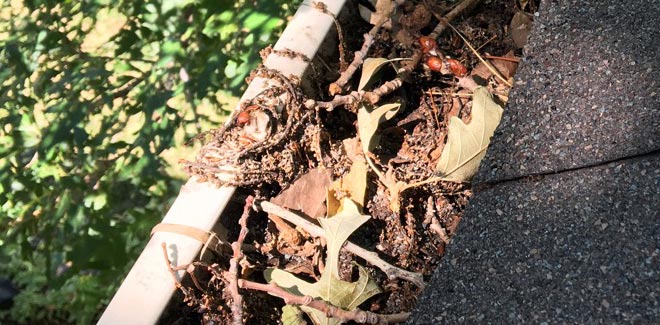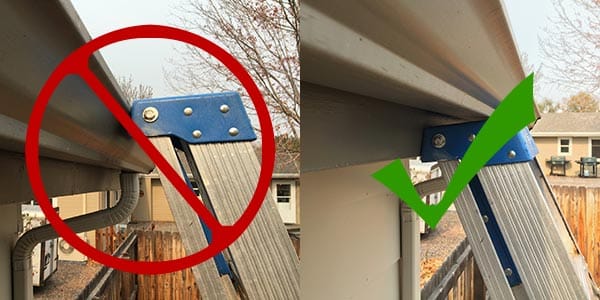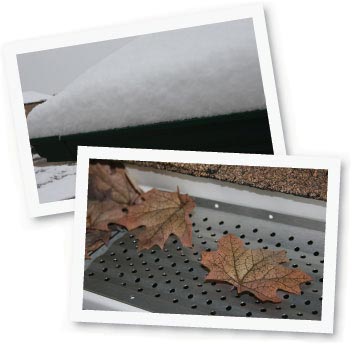
Gutter and downspout cleaning is just one of those regular maintenance things that needs to get done. Whether you do it yourself or you hire someone, you’ll rest easier knowing that that project is off your plate for a while.
Below, you’ll find our gutter cleaning tips. Feel free to leave a comment below and/or share any tips you have.
Quick links to our gutter cleaning tips below:
- Tools you’ll need
- When should you clean out your gutters
- Downspout clean-out
- Why clean your gutters and downspouts
- Ladder positioning
- Cleaning gutters from the ground
- Leaf gutter guard
Gutter and Downspout Cleaning Tools:
- Gloves
- Eye protection
- Sturdy ladder
- Hand trowel or gutter scoop
- Bucket
- Portable bucket hook (optional, but nice to have)
- Garden hose
- Gutter cleaning attachment (optional)
When Should You Clean Out Your Gutters?
You should check your gutters to see if they need to be cleaned-out at least twice a year; in the Fall and in the Spring.
Fall Gutter Cleaning
Fall is an obvious time to deal with your gutters, after all the leaves have fallen and before it snows. Snow packs down leaves which makes it more difficult, and a bigger mess, to clean. Therefore, it’ll be an easier and faster job if you can get to those leaves before they get wet.
Spring Gutter Cleaning
Also check them in the Spring because some trees don’t lose their leaves until Spring, such as some Oak trees, when new leaves are starting to come in. Also, sometimes birds find gutters attractive to build their nests in, in the Spring. Furthermore, the Winter snow and wind might have knocked-down branches into your gutters, and you’ll want to get those out so they don’t cause any further damage.
Gutter Scoop or Hand Trowel
If you’d rather not dig around in the gutters with your hands, use a gutter scoop or a hand trowel. Using one of these tools also allows you to get into the corners of the common K-style gutters and do a better job of cleaning them out.
Use a Bucket
Use a bucket to collect debris and don’t throw into your yard. Deposit into your compost or yard waste bin. Furthermore, a portable bucket hook makes it easy to hang your bucket from the gutter so you don’t have to hold-on to it, or rest it on your ladder or roof, where it might fall off.
Downspout Clean-Out; How to Flush-Out Downspouts
Rain and snow can also push leaves and other debris down your downspouts. The best way to cleanout downspouts is to remove what you can by hand from the top and bottom, then, if there’s anything still in there that you can’t reach, use a garden hose at the top of the downspout to flush them out. The force and weight of the water should push everything out.
If you’ve been cleaning your downspouts regularly, and there’s no large obstructions, such as a bird’s nest, most of the time, water from a garden hose above is enough to flush them out. If this doesn’t work, you can also try the handle of your rake or shovel or something similar to push the obstruction down, assuming you don’t have any bends in your downspout.
While you’ve got your ladder out, you may as well check for holes, cracks, breaks, any leaks and get them sealed. If you don’t, they could get worse. Leaks can also cause pooling around your foundation, or leaks into your basement and/or crawlspace, or pooling on walkways that could freeze and cause an accident.
Also check for loose screws and tighten any you see so they don’t get worse.
Why Clean Your Gutters and Downspouts?
They’ll Last Longer
The weight of wet leaves, branches, water, ice, snow, etc. in your gutters can cause them to pull away from the fascia. This is called ‘gutter detachment’. Obviously, if your gutter pulls away from your house or building, this will need to be repaired.
Prevent Costly Repairs
A build-up of rotting leaves, dirt, shingle granules, etc. over time can prematurely cause your gutters to breakdown, and the fascia and roof deck, to rot. If this happens, your gutters, fascia, etc. will need to be replaced, and that costs money. While you’re cleaning your gutters, look for other signs your gutters need repair and get them fixed as soon as possible.
Prevent Personal Injuries
If your gutters and downspouts aren’t working properly, they aren’t collecting and directly water and melting snow where they should. If you have clogged downspouts, water can’t flow down them and will run over the sides of your gutters. This will allow water to pool around your foundation which could get into your basement or crawlspace. Overflowing gutters could also allow water to collect onto walkways. If this freezes, is a serious safety issue, not only to yourself but passersby.
Ladder Positioning

Make sure to use a ladder you trust. You don’t want to have to stand on the top of your ladder and/or stretch to reach your gutters, as this can cause you to lose your balance. Also, use a ladder that’s long enough to reach the fascia. Don’t lean it against the gutter. The fascia is much more solid than the gutter, and, if you find out you have to work on the gutter, it’ll be easier to do that work if your ladder isn’t resting against it.
4-to-1 Ladder Rule
You don’t want your ladder too far away from your house or building or too close. According to Hunker: the base of the ladder needs to be about one quarter of the ladder’s length away from the surface at the top the ladder is resting against. It’s what’s called the 4-to-1 ladder rule. For example, if you have a 10 foot ladder, the base of it should be about 2.5 feet away from where the top is resting. The ladder should create a 75º angle to the ground.
Cleaning Gutters From the Ground
Cleaning your gutters from the ground is not a good idea for a couple reasons:
1. you’re going at it blindly; you can’t see what’s in your gutter or your downspout. Is there a branch in there, a nest, just leaves; you don’t know unless you get out a ladder and climb up there.
2. whatever is in your gutter, you may not want to flush that down your downspout. You want that debris in a bucket then either in your yard waste bin or compost bin. And, what if your downspouts go underground? If you flush your gutters without cleaning it first, you’re flushing that debris into the extension tubes under ground. Now your extension tubes are clogged.
Gutter Guards

The GutterRx gutter guard system is great in that it covers your gutter from back to front, yet it has holes in it so rain water or melting snow can drip though it into the gutter. What’s more, when the rain or snow stops and the sun comes-out, the holes allow air to pass through them drying-out the leaves. If the leaves don’t blow away with the wind, they remain on top so you can easily wipe them off of the gutter guard instead of digging around in the wet gutter.
The Bottom Line
Follow our gutter cleaning tips above and have your gutters and downspouts cleaned-out in no time. The more preventative gutter maintenance you do, the less damage there will be. Therefore, the less it will cost you down the road and the longer your gutters will last. We know it’s not fun to dig around in messy gutters, but you will rest easier knowing that it’s done and you don’t have to worry about it again for a while.

Comments
3 responses to “Gutter Cleaning Tips”
Thanks for the information here! Always need to just get up there and see whats clogging it up. Saves time and saves money. Great article!
Great tips you got there! Aside from using ladders to clean your gutters, I suggest using a telescopic wand for pressure washer instead. It has long reach, flexible, durable and very easy to install.
Thanks, for sharing an informative piece. My brother needs to read this as he is always concerned with house maintenance with perfection. And your post is a mini-guide to perform the gutter cleaning easily.